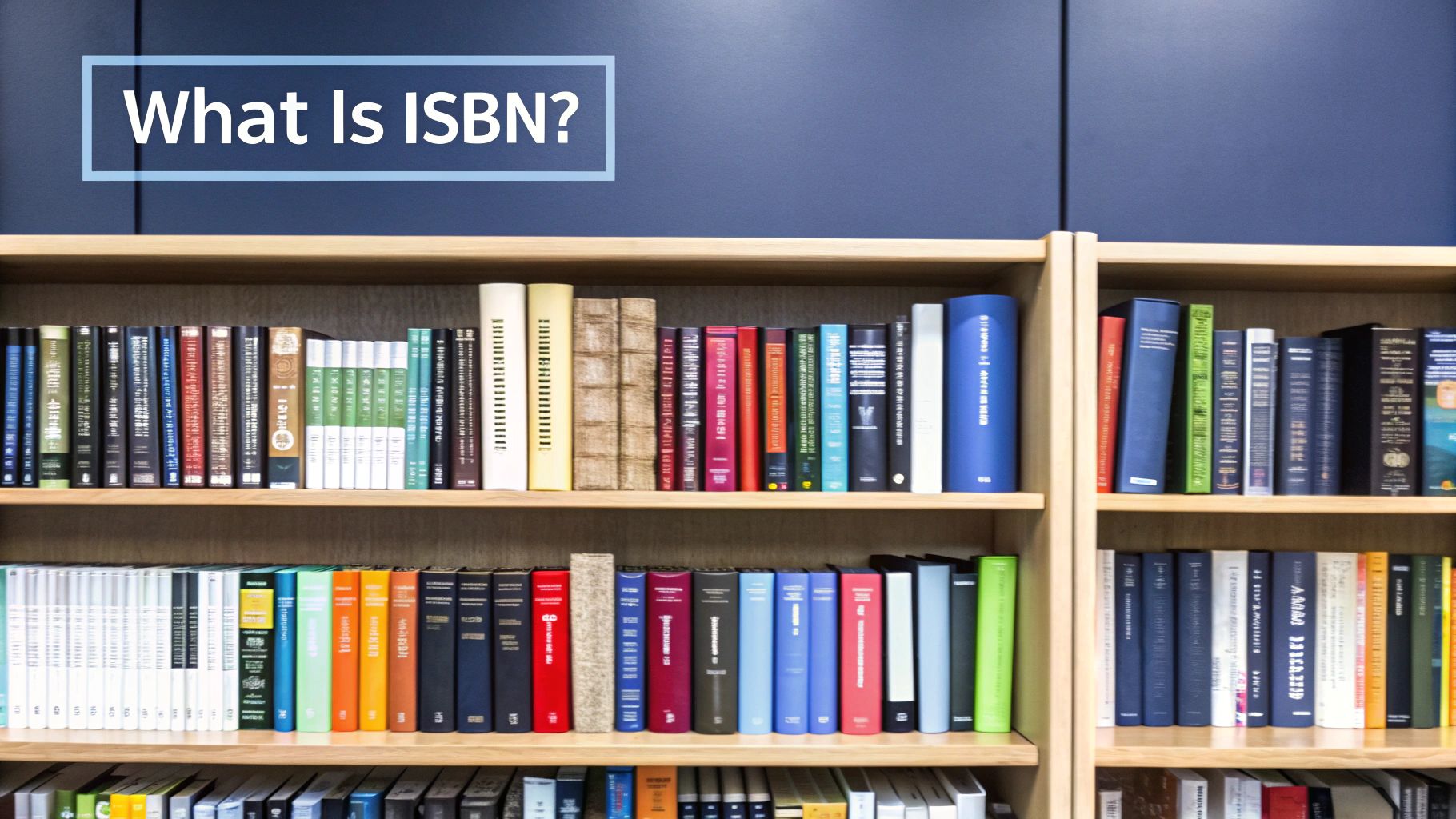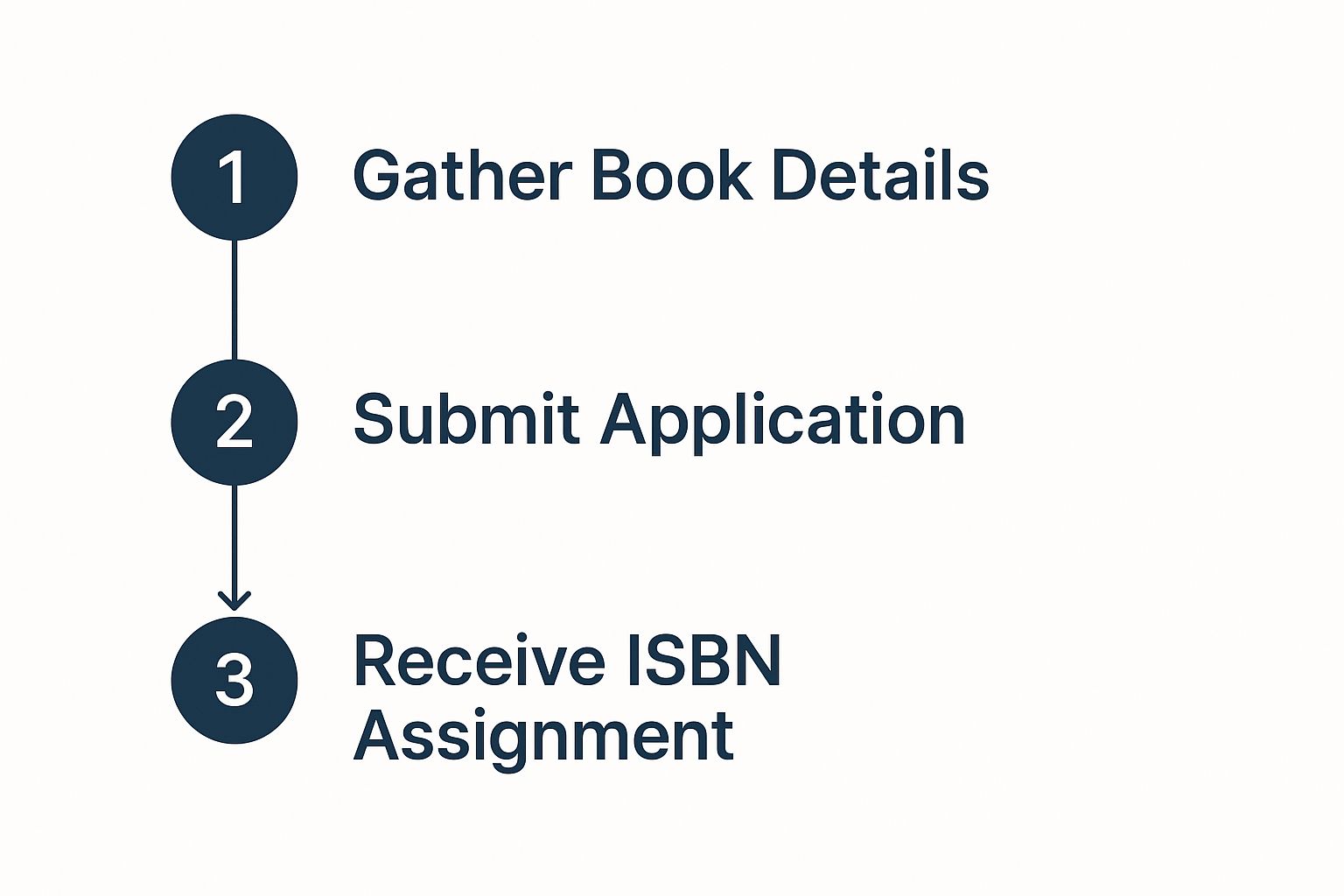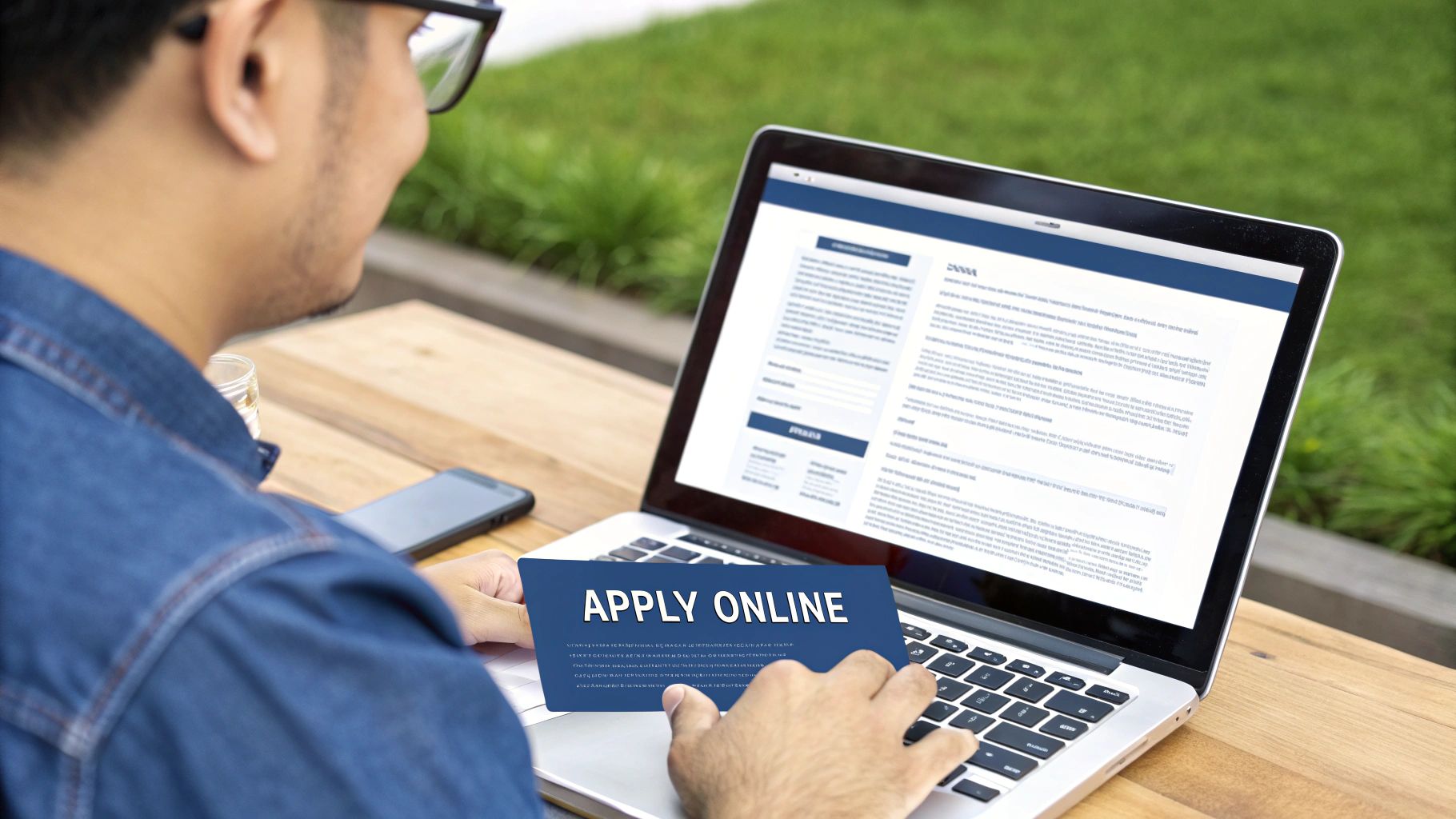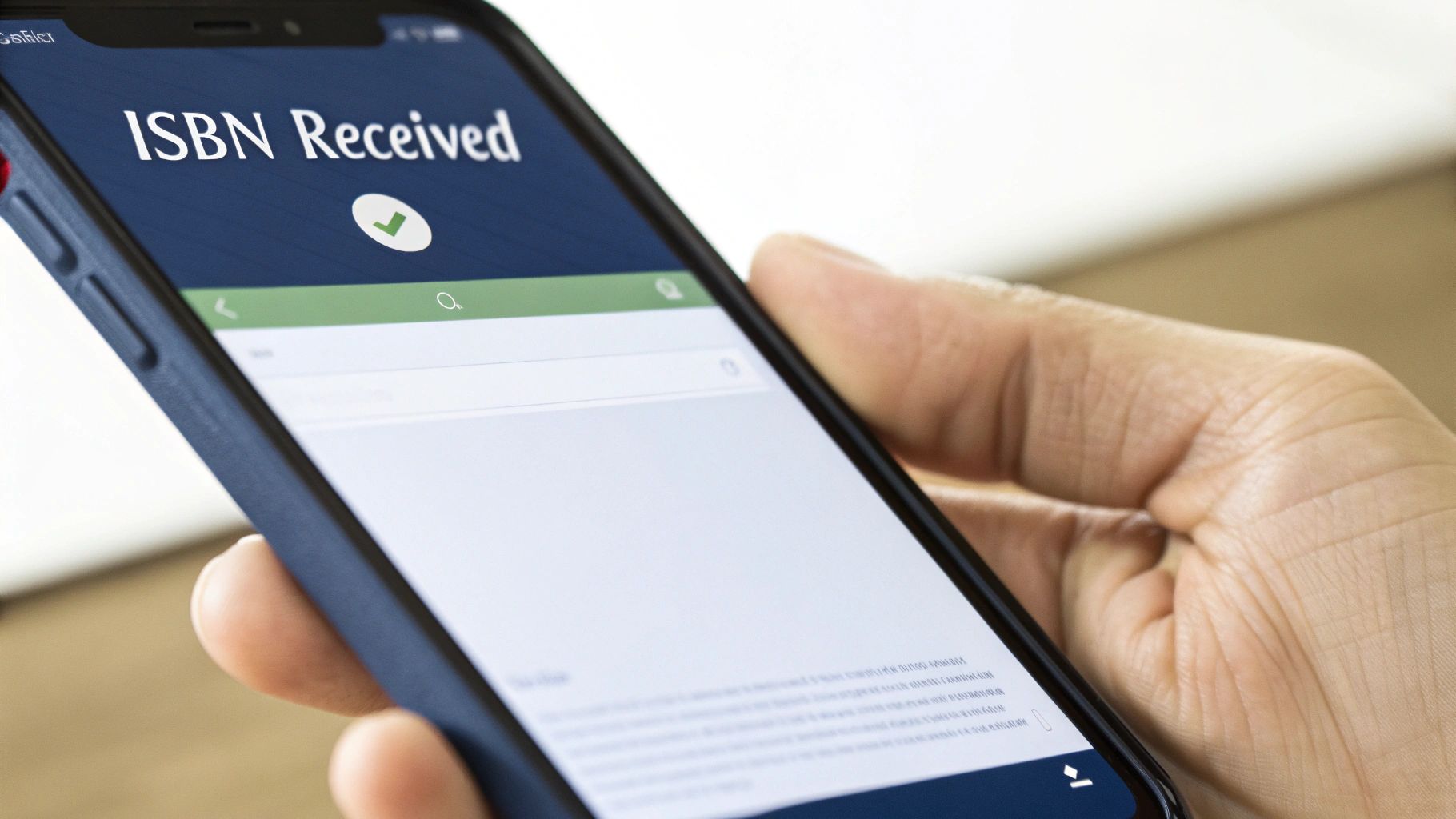Getting an ISBN for your book can feel like one of those mysterious, insider-only publishing tasks, but it's actually more straightforward than you might think. The most important thing to know right off the bat is this: to have full control over your book, you need to buy your own ISBN.
For authors publishing in the United States, the one and only official source is Bowker. While you'll see some platforms offer "free" or discounted ISBNs, there's a catch. When you use a free ISBN, the platform (like Amazon KDP or IngramSpark) is listed as the publisher of record, not you. Buying your own ensures your name or your publishing company is attached to your work, giving you complete freedom over where and how you sell it.
Your Quick Guide to Getting an ISBN
Think of an International Standard Book Number (ISBN) as your book’s unique social security number in the global marketplace. This 13-digit code is how retailers, libraries, wholesalers, and distributors track, order, and manage inventory. Without an ISBN, your book is essentially invisible to the entire traditional supply chain, making it almost impossible to get onto bookstore shelves or into library catalogs.
So, where do you start? The first step is figuring out which agency handles ISBNs for your country. The whole system is managed by the International ISBN Agency, which delegates the responsibility to over 200 individual national agencies.
This means the process looks a little different depending on where you live. For example, authors in the U.S. will go through Bowker, while those in the United Kingdom use the Nielsen ISBN Agency. For U.S. authors, your destination is the official site, MyIdentifiers.com.

As you can see, their homepage gets straight to the point, offering options to purchase ISBNs and barcodes. This is your command center for managing all the unique identifiers your book will need.
Now comes the first major decision you'll have to make in this process: how many ISBNs to buy. It's a question that trips up a lot of new authors.
The most common mistake I see is authors buying a single ISBN to save money. The problem is, every format of your book—paperback, hardcover, ebook, audiobook—needs its own unique ISBN. Buying a block of 10 is almost always the smarter, more cost-effective move for the long run.
A single ISBN from Bowker costs $125, but a block of 10 is $295. It's a significant saving per number and gives you the flexibility to release multiple formats or publish future books without having to go through the purchasing process all over again.
To give you a clearer picture, here’s a quick breakdown of your options.
ISBN Options at a Glance
This table compares the most common ways to get an ISBN, so you can see the differences in cost, ownership, and platform limitations at a glance.
| ISBN Source | Typical Cost (US) | Who is Listed as Publisher? | Best For |
|---|---|---|---|
| Buy Direct from Bowker | $125 (for 1), $295 (for 10) | You or your publishing company | Authors who want full control and plan to distribute widely across multiple platforms. |
| "Free" from KDP | $0 | Amazon | Authors publishing an ebook exclusively on Amazon Kindle. |
| "Free" from IngramSpark | $0 | IngramSpark | Authors using IngramSpark for print-on-demand who don't plan to use other printers. |
| ISBN from an Author Service | Varies (often included in a package) | The service company | Authors who prefer a done-for-you package and don't mind the third party being the publisher. |
Choosing the right path really depends on your long-term publishing goals. If you're serious about your author career, investing in your own ISBNs is a foundational step.
Of course, securing your ISBN is just one piece of the puzzle. As you move toward publication, you'll also be thinking about things like cover art. You can even explore modern resources like AI tools for book cover design to help spark some ideas.
This guide is designed to get you started, but for a more detailed walkthrough of the entire process, be sure to check out our complete resource here: https://barkerbooks.com/how-to-get-an-isbn-for-my-book/
Why Each Book Format Needs Its Own ISBN
One of the first things that trips up new authors is this idea of needing more than one ISBN. I get it. It feels like another piece of red tape in an already complicated process. But trust me, assigning a unique ISBN to each version of your book is absolutely essential for how the entire publishing world works.
Think of it like this: your paperback is a completely different product from your hardcover, and both are different from your EPUB ebook file. They each have their own production costs, different price points, and they are tracked separately in warehouses and bookstores. That unique number is the only way a distributor or retailer can be sure they're ordering, stocking, and selling the right version.
Imagine a reader ordering the beautiful hardcover edition of your novel as a birthday gift. If it shared the same ISBN with the paperback, a warehouse worker could easily grab the wrong one. The result? A disappointed customer, a likely return, and a logistical headache for major players like Amazon or IngramSpark.
Format Variations That Require New ISBNs
The rule of thumb is pretty simple: if a version of your book is different enough to be sold as a separate item, it needs its own ISBN. This isn't just a friendly suggestion—it’s a non-negotiable part of getting your book into the supply chain.
So, when will you need to get a new ISBN? Here are the most common scenarios:
- Binding: Your paperback and hardcover versions are treated as distinct products.
- Ebook Files: An EPUB for platforms like Apple Books and a MOBI file for Kindle are considered separate formats.
- Audiobook: The digital download of your audiobook is a completely different product from any text-based version.
- Large Print: A special large-print edition has a different layout and page count, so it gets its own number.
As you think about all these versions, exploring effective content repurposing strategies can open up new ways to connect with readers, though each new format will likely need its own ISBN.
When Revisions and New Editions Need an ISBN
It’s not just about the format. Big changes to your book's content also mean you'll need a new ISBN. The key word here is "big." What counts as a significant change?
Fixing a few typos, making a minor tweak to the cover art, or correcting a small grammatical mistake? You’re probably fine. You don't need a new ISBN for that. But if you make changes so substantial that a reader with the old version would feel they're missing out, it's time for a fresh number.
A new ISBN is required when there are substantial changes to the text. For example, adding, moving, or deleting blocks of text or chapters constitutes a new edition that needs a new ISBN. This signals to distributors and readers that the product has been updated in a meaningful way.
Here’s a real-world example I see all the time: an author of a non-fiction book on marketing releases a second edition. They’ve added three new chapters on social media and updated all the case studies. Using the first edition's ISBN would be a huge disservice to their audience. A new ISBN clearly marks it as the "Second Edition," preventing confusion and ensuring everyone knows they're buying the latest, most relevant information.
How to Buy and Assign an ISBN from Bowker
If you're publishing from the United States, your journey to getting an ISBN will go through one place: Bowker. Their website, MyIdentifiers.com, is the only official source. While the process itself is pretty direct, the choices you make here are important. Think of it as laying the official foundation for your book's life in the marketplace.
First things first, you'll need to create an account. Once you're logged in, you'll see a few different purchasing options. You can buy a single ISBN for $125, but I find myself telling authors to avoid this route almost every time. The smartest investment, by a long shot, is the block of 10 ISBNs for $295.
Why the big jump? Because every single version of your book needs its own, unique ISBN. That means your paperback is one product, your hardcover is another, and your EPUB is a third. Buying in bulk sets you up for different formats and even future books, saving you from paying that steep single-ISBN price over and over again.
Choosing the Right Package for Your Goals
Your long-term publishing plans should really drive this decision. A single ISBN might seem like enough if you're only thinking about one ebook right now. But what happens when it becomes a bestseller and readers are clamoring for a paperback? You'll be back at square one, paying that premium price for another single number.
Let's walk through a few real-world scenarios:
- The Debut Author: You’ve written your first novel and want to release it as both a paperback and an ebook. Right there, you need two separate ISBNs.
- The Series Writer: You've mapped out a trilogy. That's at least three paperbacks and three ebooks, meaning you'll need a minimum of six ISBNs to launch the full series.
- The Non-Fiction Expert: You release a groundbreaking book, and a year later, you update it with two new chapters. That revised second edition is considered a new product and requires a brand-new ISBN.
In all of these common situations, the 10-pack just makes more sense. It's the most economical path forward and keeps you from hitting a logistical roadblock right when you should be celebrating your launch.
This graphic gives you a bird's-eye view of the process once you've purchased your numbers.

As you can see, once you have your book's details finalized, the actual assignment is a straightforward step.
Assigning Your ISBN and Getting the Metadata Right
Once you've made your purchase, the ISBNs will be waiting for you in your MyIdentifiers account. Now for the crucial part: assigning one to your book and entering its metadata. This isn't just filling out a form; this is the information that feeds into Amazon listings, library catalogs, and distributor systems across the globe.
A Word of Caution: I can't stress this enough—do not assign an ISBN until your book's core details are set in stone. Once you assign an ISBN, the title, subtitle, and trim size are locked. I've seen authors make this mistake, and it’s a costly one to fix.
The metadata you enter is incredibly powerful. It contains coded information, like a prefix for the country and a unique publisher identifier, that allows the entire industry to track and understand publishing trends. This system acts like a digital fingerprint for every book, revealing the true publisher behind the title. You can actually see how this data is used to map the industry by reading these insights on global publishing behavior.
When you click "Assign Title," you'll be prompted to fill out several key fields:
- Title and Subtitle: These must match your cover and title page exactly. No exceptions.
- Author/Contributor: This is where you list your name or your publishing company's name.
- Book Format & Trim Size: Be specific. Is it a paperback, hardcover, or ebook? If it’s a print book, what are the dimensions (e.g., 6×9 inches)?
- BISAC Codes: Think of these as the shelf categories in a bookstore. Don't be generic. Instead of just "FICTION," drill down to something like "FICTION / Thrillers / Espionage."
Getting this metadata right from the start directly impacts how easily readers can find your book. Accurate data ensures your book appears in the right online searches and gets into the hands of the people who are most likely to buy it.
Navigating International And ‘Free’ ISBN Options

If you’re a U.S.-based author, you’ll head straight to Bowker for your ISBN. But for everyone else, the path isn't quite as straightforward. Each country has its own national agency that handles ISBN registration, and each one operates a little differently with its own rules and costs.
It’s fascinating to see how these markets differ. We've seen significant growth in new titles getting ISBNs in countries like France (12.5%), Brazil (10%), and Italy (7.3%). Yet, during a similar timeframe, the UK market saw a 10% dip. It's a clear reminder that publishing is a global business with very local nuances. You can dive deeper into these global publishing trends on Google Books if you're curious.
Finding Your National ISBN Agency
So, where do you start? The first step is figuring out which agency serves your country. The best place to do that is on the International ISBN Agency's website, which maintains a global directory.
Just to give you an idea of how much it varies, here are a few examples:
- Canada: Canadian authors are in luck! Library and Archives Canada provides ISBNs at no cost.
- United Kingdom: In the UK, authors purchase their ISBNs through the Nielsen ISBN Store.
- Australia: Down under, Thorpe-Bowker is the official agency handling ISBNs.
Since every agency has its own application process, make sure you read their guidelines carefully before you begin.
The Truth About ‘Free’ ISBNs
You’ve probably seen it offered on platforms like Amazon KDP or IngramSpark: a "free" ISBN. It sounds like a great deal, especially when you’re watching your budget. But I’ll be honest—that convenience comes with a significant string attached, one that affects your control and your book's future.
Here’s the catch: when you accept a free ISBN, the platform giving it to you becomes the publisher of record. That means "Amazon" or "IngramSpark" gets listed as the publisher in your book's official data, not you or your publishing imprint. This can limit your distribution and change how your book is perceived in the industry.
A free, platform-provided ISBN is essentially locked to that platform. You can't take an Amazon-assigned ISBN and use it to print your book somewhere else or sell it through another distributor. If you wanted to switch, you'd have to get a brand new ISBN, which creates a messy situation for your sales history and author brand.
This is a make-or-break decision for authors who want total creative and business control. If you're publishing an ebook, for example, owning your ISBN gives you the freedom to sell on any platform you choose. Our guide on how to publish an ebook covers more on this topic.
To make things crystal clear, let's break down the key differences between buying your own ISBN and using a "free" one.
Owned ISBN vs. 'Free' Platform ISBN
The choice between a purchased ISBN and a free one boils down to control versus cost. This table lays out exactly what you get—and what you give up—with each option.
| Feature | Owned ISBN (e.g., from Bowker) | Platform-Provided 'Free' ISBN |
|---|---|---|
| Publisher of Record | You or your publishing company. | The platform (e.g., Amazon, IngramSpark). |
| Distribution | Usable on any platform, with any printer, anywhere. | Locked to the platform that issued it. |
| Flexibility | Maximum control to move between printers and distributors. | No flexibility; you're tied to one service. |
| Cost | Upfront investment required. | No direct cost to the author. |
Ultimately, paying for your own ISBN is an investment in your author career. It ensures you remain in the driver's seat, with the freedom to make the best decisions for your book now and in the future.
Common ISBN Mistakes Authors Make
Let's be honest, navigating the world of ISBNs for the first time can feel like walking through a minefield. It’s easy to make a small misstep that leads to major distribution headaches down the road. The good news? Once you know what to look for, these mistakes are entirely preventable.
The single biggest mistake I see authors make is trying to reuse an ISBN for a new version of their book. You have to remember: an ISBN is tied to a specific format and edition. If you release a paperback and later decide to publish a hardcover, that hardcover absolutely must get its own, brand-new ISBN. The same rule applies to ebooks, audiobooks, and even significant revisions of the same format.
I once worked with an author who added two new chapters to their non-fiction book but kept the original ISBN, thinking it would save a few bucks. The result was a logistical nightmare. Retailers’ systems got confused, customers received outdated versions from old stock, and the entire relaunch fell flat. A new edition always, always requires a new identifier.
The Dangers of Unauthorized Resellers
Another huge pitfall is buying so-called "discount" ISBNs from unauthorized third-party websites. It's tempting, I get it. You'll see sites offering single ISBNs for a fraction of the official price. Here's the catch: the official agency (like Bowker in the U.S.) remains the publisher of record for those numbers.
That means the reseller—not you—is listed as the publisher in global databases. This can muddy your author brand and might even violate the terms of service for major distributors like Amazon KDP or IngramSpark. Always buy directly from your country's designated ISBN agency. This is the only way to ensure you are listed as the official publisher, a small detail that has a massive impact on your author business and the overall cost to publish a book.
Your Pre-Assignment Checklist
Think of assigning an ISBN as the final, irreversible step before your book goes public. Before you hit that "assign" button in your account, take a deep breath and run through this quick mental checklist:
- Is my title and subtitle 100% final? Once an ISBN is assigned, the title is set in stone.
- Is my author name or imprint spelled correctly? This is how the world will see you as the publisher.
- Is the trim size locked in? The physical dimensions of your print book are tied directly to this number.
So, what happens if you've already made one of these mistakes? Don't panic. If you've just entered the metadata and the book isn't for sale yet, you can usually log back into your ISBN agency account and make corrections.
If the book is already out in the wild, however, the fix is more involved. You’ll probably need to retire the old, incorrect ISBN, assign a completely new one to the corrected version, and then start the tedious process of notifying all your distributors about the change. It's a hassle you can easily avoid with a little upfront diligence.
Your Questions About ISBNs Answered

As you get closer to publishing, you'll inevitably have a few nagging questions about ISBNs. It’s completely normal. Let's clear up some of the most common ones I hear from authors so you can move forward with confidence.
A big one is whether you actually need an ISBN if you're just selling your book from your own website. The short answer? Technically, no. If you’re the only person selling it and you handle all the shipping yourself, you can get by without one.
But here’s my advice: get one anyway. The moment you decide you want to sell through Amazon, Barnes & Noble, or get your book into a single library, that ISBN becomes non-negotiable. Getting it from the start just keeps your options open and saves you a major headache down the road.
ISBNs vs. Barcodes: What's the Difference?
It’s easy to mix these two up, but they have distinct jobs.
- The ISBN: This is the 13-digit number that acts as your book's unique identifier. Think of it as the fingerprint for your specific edition—the paperback of My Awesome Novel, for example. It's the essential data.
- The Barcode: This is the scannable image that visually represents the ISBN, usually with the price embedded. Retailers scan this at the checkout counter.
You can't have a barcode without first having an ISBN. Agencies like Bowker make this simple by offering barcode generation as an add-on when you buy your ISBNs.
Can I Reuse an ISBN?
This is a question I get all the time, and the answer is an emphatic and absolute no.
An ISBN is assigned to one specific format of one specific book—permanently. You can’t reuse it for a different book, and you can't even use it for a different version (like an audiobook or hardcover) of the same book.
Think of an ISBN as a permanent, unchangeable birth certificate for that one specific version of your book. Reusing one would be like trying to give two different people the same social security number—it breaks the entire system.
This is precisely why you need to have your title, trim size, and other key details locked in before you officially assign that number.
The entire global publishing industry depends on this system's integrity. Trade books make up over 50% of all titles in many countries, and in places like Japan and Italy, that figure skyrockets to 97%. And with digital and audio formats accounting for nearly 65.9% of new ISBN registrations in markets like Brazil, you can see why unique identifiers are so critical. You can dig deeper into these numbers in this analysis of the global publishing industry.
Ready to turn your manuscript into a professionally published book with global reach? The team at BarkerBooks has helped over 7,500 authors navigate every step of the journey, from editing and design to ISBN registration and worldwide distribution. Let us help you achieve your publishing dream. Learn more about our author services.
